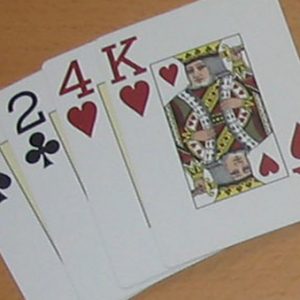Strategy Differences Between Omaha and Omaha Hi-Lo – Part 2

Last week, we started a series talking about the differences in strategies between Omaha Hi and Omaha Hi-Lo. The subtle differences are important to note as it can make the difference between winning and losing sessions.
Quartering
When someone is quartered in Omaha Hi-Lo, that means that they split one half of the pot with another player. This usually happens when someone ties someone for the low half of the pot. Very often, this happens when multiple players have A-2 and hit nut low.
The best way to avoid quartering is to not play in many multi-way pots with just a low draw. Sometimes these situations are unavoidable, but if the pot is multi-way and you have just a low draw, you should avoid calling multiple bets.
To give you an example of how costly this can potentially be, if you are quartered in a four-way pot that goes to showdown, you only get back the bets you put into the pot. Most people will chase after a chop without considering the consequences of quartering. You will lose money in most pots you are quartered in.
Counterfeiting
Another issue that you will experience more in Omaha Hi-Lo than in Omaha Hi is counterfeiting. Counterfeiting is when a card comes on the board that makes your nut low or nut low draw inferior.
For example, let’s assume you have A-2-5-7 and the flop fall A-3-8. Now you have the second nut low. A player with 2-4 will have the nut low. Or let’s say you have A-2-K-Q and the flop falls 3-5-7. A turn 2 will give a player with A-4 a wheel and you’re now about third best.
When playing for low, you have to reevaluate your hand after every round to ensure you still have the nuts. Playing starting hands that give you a virtually uncounterfeitable hand helps to combat this. Hands like A-2-3-7, A-3-4-6, and others help prevent you from getting counterfeited. Otherwise, it is, unfortunately, a part of the game that you have to adjust to when it happens.
Value Bets
Value bets in Omaha are going to vary depending on the game. In Omaha Hi, you are looking for situations where you have the nuts and your opponent has a 2nd best hand that they are likely to call you with.
An example would be you having the nut straight and them having a sucker end. In these spots, you want to be about half the size of the pot or less in order to give them an excuse to call.
Can your #bluffs become value-bets? https://t.co/k7JCkH2CH9 Apparently, if you are playing Pot Limit Omaha, they can!
— PokerVIP (@PokerVIP) July 9, 2015
In Omaha Hi-Lo, your value bets are going to depend on a few factors. First, do you have the nuts? If so, you will want to bet out in most spots. Is there any chance you are going to be quartered? If you have nut low only against multiple players that have not shown any aggression to this point, you may want to hold off.
However, if they have been betting the whole way and now the low is out there, throw in a bet and see if they will call you down. Are you in a multi-way pot either with the nuts or against apparent low draw? If so, bet out. You will make money regardless of whether they have low.
As you can see from above, both Omaha Hi and Omaha Hi-Lo have different strategies that must be adhered to in order to be successful. You cannot go and mix strategies together and hope to be successful long term. Play the game the way it should be played and you should be a winner in the long term.
